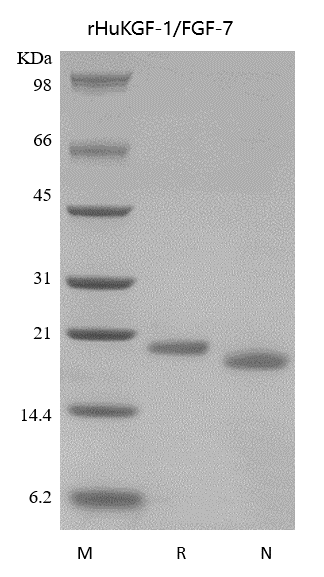- Synonyms
- HBGF-7
- Source
- Escherichia coli.
- Molecular Weight
- Approximately 18.9 kDa, a single, non-glycosylated polypeptide chain containing 163 amino acids.
- AA Sequence
- CNDMTPEQMA TNVNCSSPER HTRSYDYMEG GDIRVRRLFC RTQWYLRIDK RGKVKGTQEM KNNYNIMEIR TVAVGIVAIK GVESEFYLAM NKEGKLYAKK ECNEDCNFKE LILENHYNTY ASAKWTHNGG EMFVALNQKG IPVRGKKTKK EQKTAHFLPM AIT
- Purity
- > 96 % by SDS-PAGE and HPLC analyses.
- Biological Activity
- Fully biologically active when compared to standard. The ED50 as determined by thymidine uptake assay using FGF-receptors transfected BaF3 cells is less than 10 ng/ml, corresponding to a specific activity of > 1.0 × 105 IU/mg.
- Physical Appearance
- Sterile Filtered White lyophilized (freeze-dried) powder.
- Formulation
- Lyophilized from a 0.2 µm filtered solution in 20 mM PB, 0.5 M NaCl, pH 8.0.
- Endotoxin
- Less than 1 EU/µg of rHuKGF-1/FGF-7 as determined by LAL method.
- Reconstitution
- We recommend that this vial be briefly centrifuged prior to opening to bring the contents to the bottom. Reconstitute in sterile distilled water or aqueous buffer containing 0.1% BSA to a concentration of 0.1-1.0 mg/mL. Stock solutions should be apportioned into working aliquots and stored at ≤ -20 °C. Further dilutions should be made in appropriate buffered solutions.
- Stability & Storage
- Use a manual defrost freezer and avoid repeated freeze-thaw cycles.
- 12 months from date of receipt, -20 to -70 °C as supplied.
- 1 month, 2 to 8 °C under sterile conditions after reconstitution.
- 3 months, -20 to -70 °C under sterile conditions after reconstitution.
- Usage
- This material is offered by Shanghai PrimeGene Bio-Tech for research, laboratory or further evaluation purposes. NOT FOR HUMAN USE.
- SDS-PAGE

- Reference
- 1. Mattei MG, deLapeyriere O, Bresnick J, et al. 1995. Mamm Genome. 6:196-7.
2. Kelley MJ, Pech M, Seuanez HN, et al. 1992. Proc Natl Acad Sci U S A. 89:9287-91.
3. de Giorgi V, Sestini S, Massi D, et al. 2007. Dermatol Clin. 25:477-85, vii.
4. Eswarakumar VP, Lax I, Schlessinger J. 2005. Cytokine Growth Factor Rev. 16:139-49.
5. Belleudi F, Leone L, Nobili V, et al. 2007. Traffic. 8:1854-72.
6. Ornitz DM, Xu J, Colvin JS, et al. 1996. J Biol Chem. 271:15292-7.
7. Zhang X, Ibrahimi OA, Olsen SK, et al. 2006. J Biol Chem. 281:15694-700.
- Background
- Human KGF-1 also known as Fibroblast growth factor 7 (FGF-7), is encoded by the FGF7 gene. KGF-1 only binds to the b splice form of the tyrosine kinase receptor, FGFR2b/KGFR. Affinity between KGF-1 and its receptor can be increased by heparin or heparan sulfate proteoglycan. FGF-10, also called keratinocyte growth factor 2 (KGF-2), shares 51 % amino acid sequence identity and similar function to KGF-1, but uses an additional receptor, FGFR2c. KGF-1 plays an important role in the regulation of embryonic development, cell proliferation and cell differentiation. KGF-1 actives on keratinocytes, and exhibits mitogenic activity for epidermal cells, but essentially no activity for fibroblasts. KGF-1 has species crossactive, human KGF-1 shares 96 % amino acid sequence identity with murine, and 92 % with rat.







 COA申请
COA申请
